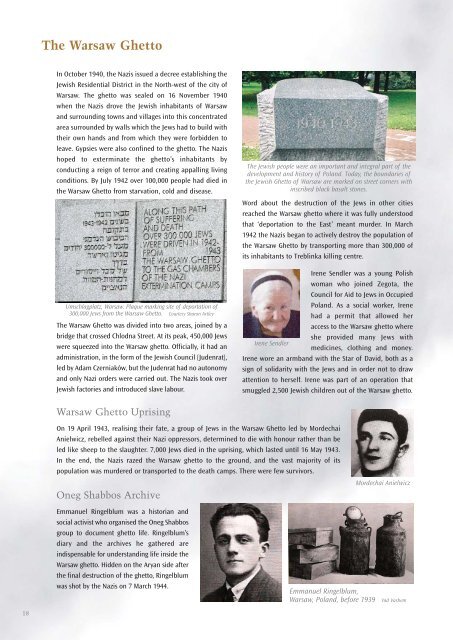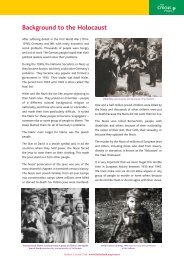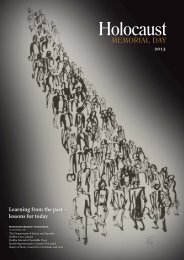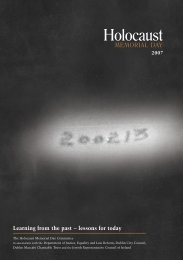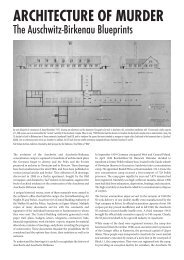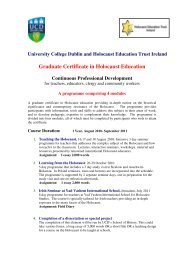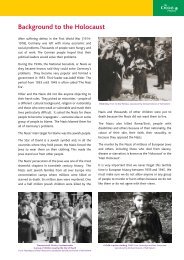Learning from the past ~ lessons for today - Holocaust Education ...
Learning from the past ~ lessons for today - Holocaust Education ...
Learning from the past ~ lessons for today - Holocaust Education ...
You also want an ePaper? Increase the reach of your titles
YUMPU automatically turns print PDFs into web optimized ePapers that Google loves.
The Warsaw Ghetto<br />
In October 1940, <strong>the</strong> Nazis issued a decree establishing <strong>the</strong><br />
Jewish Residential District in <strong>the</strong> North-west of <strong>the</strong> city of<br />
Warsaw. The ghetto was sealed on 16 November 1940<br />
when <strong>the</strong> Nazis drove <strong>the</strong> Jewish inhabitants of Warsaw<br />
and surrounding towns and villages into this concentrated<br />
area surrounded by walls which <strong>the</strong> Jews had to build with<br />
<strong>the</strong>ir own hands and <strong>from</strong> which <strong>the</strong>y were <strong>for</strong>bidden to<br />
leave. Gypsies were also confined to <strong>the</strong> ghetto. The Nazis<br />
hoped to exterminate <strong>the</strong> ghetto’s inhabitants by<br />
conducting a reign of terror and creating appalling living<br />
conditions. By July 1942 over 100,000 people had died in<br />
<strong>the</strong> Warsaw Ghetto <strong>from</strong> starvation, cold and disease.<br />
Umschlagplatz, Warsaw. Plaque marking site of deportation of<br />
300,000 Jews <strong>from</strong> <strong>the</strong> Warsaw Ghetto. Courtesy Sharon Artley<br />
The Warsaw Ghetto was divided into two areas, joined by a<br />
bridge that crossed Chlodna Street. At its peak, 450,000 Jews<br />
were squeezed into <strong>the</strong> Warsaw ghetto. Officially, it had an<br />
administration, in <strong>the</strong> <strong>for</strong>m of <strong>the</strong> Jewish Council (Judenrat),<br />
led by Adam Czerniaków, but <strong>the</strong> Judenrat had no autonomy<br />
and only Nazi orders were carried out. The Nazis took over<br />
Jewish factories and introduced slave labour.<br />
The Jewish people were an important and integral part of <strong>the</strong><br />
development and history of Poland. Today, <strong>the</strong> boundaries of<br />
<strong>the</strong> Jewish Ghetto of Warsaw are marked on street corners with<br />
inscribed black basalt stones.<br />
Word about <strong>the</strong> destruction of <strong>the</strong> Jews in o<strong>the</strong>r cities<br />
reached <strong>the</strong> Warsaw ghetto where it was fully understood<br />
that ‘deportation to <strong>the</strong> East’ meant murder. In March<br />
1942 <strong>the</strong> Nazis began to actively destroy <strong>the</strong> population of<br />
<strong>the</strong> Warsaw Ghetto by transporting more than 300,000 of<br />
its inhabitants to Treblinka killing centre.<br />
Irene Sendler was a young Polish<br />
woman who joined Zegota, <strong>the</strong><br />
Council <strong>for</strong> Aid to Jews in Occupied<br />
Poland. As a social worker, Irene<br />
had a permit that allowed her<br />
access to <strong>the</strong> Warsaw ghetto where<br />
she provided many Jews with<br />
Irene Sendler<br />
medicines, clothing and money.<br />
Irene wore an armband with <strong>the</strong> Star of David, both as a<br />
sign of solidarity with <strong>the</strong> Jews and in order not to draw<br />
attention to herself. Irene was part of an operation that<br />
smuggled 2,500 Jewish children out of <strong>the</strong> Warsaw ghetto.<br />
Warsaw Ghetto Uprising<br />
On 19 April 1943, realising <strong>the</strong>ir fate, a group of Jews in <strong>the</strong> Warsaw Ghetto led by Mordechai<br />
Anielwicz, rebelled against <strong>the</strong>ir Nazi oppressors, determined to die with honour ra<strong>the</strong>r than be<br />
led like sheep to <strong>the</strong> slaughter. 7,000 Jews died in <strong>the</strong> uprising, which lasted until 16 May 1943.<br />
In <strong>the</strong> end, <strong>the</strong> Nazis razed <strong>the</strong> Warsaw ghetto to <strong>the</strong> ground, and <strong>the</strong> vast majority of its<br />
population was murdered or transported to <strong>the</strong> death camps. There were few survivors.<br />
Oneg Shabbos Archive<br />
Mordechai Anielwicz<br />
Emmanuel Ringelblum was a historian and<br />
social activist who organised <strong>the</strong> Oneg Shabbos<br />
group to document ghetto life. Ringelblum’s<br />
diary and <strong>the</strong> archives he ga<strong>the</strong>red are<br />
indispensable <strong>for</strong> understanding life inside <strong>the</strong><br />
Warsaw ghetto. Hidden on <strong>the</strong> Aryan side after<br />
<strong>the</strong> final destruction of <strong>the</strong> ghetto, Ringelblum<br />
was shot by <strong>the</strong> Nazis on 7 March 1944.<br />
Emmanuel Ringelblum,<br />
Warsaw, Poland, be<strong>for</strong>e 1939 Yad Vashem<br />
18


